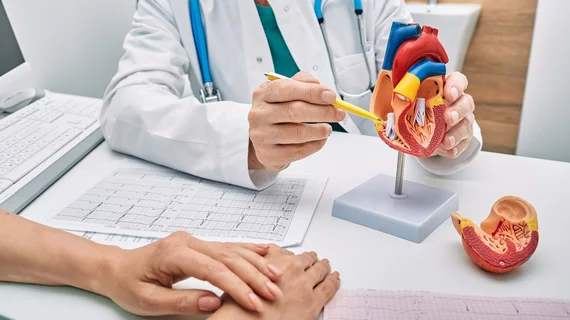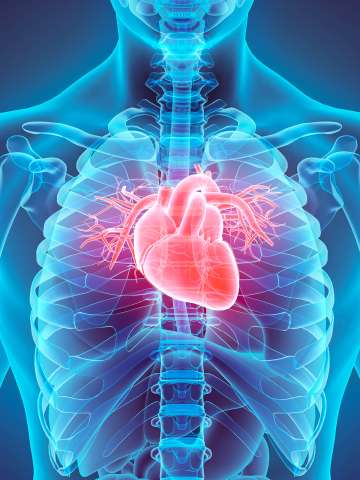Who needs a Cardiologist near me and when to book an appointment
Who needs a Cardiologist near me and when to book an appointment
Blog Article
Understanding the Relevance of Cardiology in Modern Healthcare Services
Cardiology plays a vital function in contemporary healthcare, particularly as heart condition continues to be the leading source of death worldwide. Developments in diagnostics and treatment have actually changed client care, enabling earlier treatments and improved end results. The change in the direction of preventive cardiology empowers individuals to manage their health proactively. As innovation proceeds to evolve, the combination of ingenious options may further redefine cardiology's effect on public wellness, motivating a closer exam of arising trends and their ramifications.
The Frequency of Heart Condition and Its Effect On Public Health And Wellness
Heart condition remains the leading reason of fatality worldwide, its impact extends much past private patients to influence public health systems and economies. The high prevalence of cardiovascular disease puts a substantial strain on medical care resources, demanding enhanced financing for therapy, prevention, and recovery programs. Public wellness initiatives should attend to risk elements such as obesity, cigarette smoking, and inactive way of lives, which contribute considerably to the rising incidence of heart conditions.Moreover, the financial problem related to heart disease is immense, encompassing not just direct clinical prices but also indirect expenditures associated with lost performance and premature mortality. Areas deal with difficulties in handling these costs, frequently leading to disparities in medical care gain access to and results. As the population ages and lifestyle-related risks remain to intensify, the urgency for reliable cardiology treatments comes to be paramount. As a result, addressing heart problem is not just an issue of specific health yet likewise an important public health and wellness priority.
Advancements in Cardiac Diagnostics and Imaging Techniques
Recent advancements in heart diagnostics and imaging strategies have reinvented the area of cardiology, enhancing the ability to spot and check heart illness. Methods such as cardiac MRI, CT angiography, and echocardiography have actually come to be increasingly sophisticated, offering comprehensive pictures of cardiac structures and features. These techniques enable the very early recognition of conditions like coronary artery condition, cardiac arrest, and valvular disorders.Moreover, innovations in non-invasive diagnostics, such as wearable modern technology and remote surveillance tools, have equipped patients and doctor. These tools promote real-time monitoring of heart rhythms and various other essential indications, bring about prompt interventions. In addition, expert system is being incorporated into imaging evaluation, enhancing accuracy and effectiveness in medical diagnosis.
Innovations in Therapy Choices for Heart Issues
Current advancements in cardiology have actually led to considerable developments in treatment alternatives for heart disease. These include innovative medical methods that improve step-by-step results and emerging medications that use new avenues for therapy. As the field advances, these technologies play a vital function in enhancing person treatment and results.
Advanced Surgical Techniques
Innovations in medical strategies have changed the landscape of cardiology, supplying brand-new expect individuals with heart conditions. Minimally intrusive treatments, such as catheter-based interventions, have substantially decreased recuperation times and health center keeps. Strategies like robotic-assisted surgery improve precision, permitting surgeons to navigate complicated anatomical structures with greater accuracy. In addition, developments in imaging innovation help with real-time visualization during procedures, enhancing end results. Transcatheter aortic shutoff substitute (TAVR) exhibits a development in dealing with aortic constriction, making it possible for shutoff replacement without open-heart surgery. Furthermore, hybrid techniques that incorporate catheter-based and surgical methods supply tailored remedies for various heart concerns. These sophisticated medical techniques not just enhance client safety yet also broaden treatment alternatives, highlighting the vital role of advancement in modern cardiology practices.
Arising Medications and Therapies
As the landscape of cardiology proceeds to evolve, arising medicines and therapies play an essential role in enhancing treatment options for heart problems. Advancements such as unique anticoagulants and progressed lipid-lowering agents have transformed the administration of cardiovascular conditions, greatly minimizing patient morbidity and mortality. In addition, the growth of genetics treatments and regenerative medicine supplies promising methods for dealing with conditions formerly deemed incurable. Professional trials are continually revealing the efficiency of these therapies, pressing the borders of conventional treatments. The assimilation of digital wellness technologies promotes individualized medicine, enabling for customized therapy plans based on genetic and way of living elements. Collectively, these improvements underscore the vibrant nature of cardiology, improving person end results and redefining standards of treatment in contemporary medical care.
The Duty of Preventive Cardiology in Patient Treatment
Preventative cardiology plays an important role in patient care by concentrating on the identification of risk factors that add to heart disease. Via way of living alteration strategies and very early detection methods, doctor can efficiently reduce the incidence of cardio occasions - Cardiology. This proactive approach not only enhances person results yet additionally promotes long-lasting health and wellness
Risk Variable Identification
While heart diseases remain a leading reason for morbidity and mortality worldwide, effective risk aspect identification functions as a keystone of preventative cardiology. Recognizing danger elements such as hypertension, family, hyperlipidemia, and diabetes mellitus history is necessary for very early intervention. Healthcare professionals utilize different screening methods to assess these factors, enabling tailored precautionary steps. Furthermore, recognizing a person's way of life choices, such as cigarette smoking and physical lack of exercise, better notifies danger evaluations. This thorough examination enables clinicians to create individualized care strategies focused on mitigating risks. By prioritizing danger variable recognition, medical care systems can boost patient end results and lower the general burden of heart diseases, eventually contributing to improved public wellness methods and source appropriation.
Way Of Living Alteration Approaches
A plethora of research studies highlights the crucial function of lifestyle modification strategies in lowering heart disease danger. These methods include dietary changes, increased physical task, smoking cessation, and weight monitoring. By taking on a heart-healthy diet regimen abundant in fruits, vegetables, entire grains, and lean proteins, people can lower cholesterol levels and high blood pressure. Routine physical task reinforces the heart and improves total cardio health. In addition, giving up cigarette smoking significantly decreases the danger of heart problem and improves healing rates for those with current conditions. Weight administration even more adds to cardio wellness by reducing various other danger aspects such as diabetes and hypertension. Applying these way of living changes not just advertises private health but also works as a foundation of precautionary cardiology in patient care.
Very Early Detection Techniques
Way of living adjustments substantially add to reducing heart disease threats, yet they are most effective when coupled with early detection methods. Preventive cardiology emphasizes the relevance of determining possible heart problems prior to they escalate right into serious conditions. Techniques such as blood stress surveillance, cholesterol screening, and advanced imaging modern technologies like echocardiograms play important functions in reviewing cardiovascular health and wellness. Biomarkers and genetic screening additionally boost the precision of very early detection, permitting customized preventive techniques. Regular heart danger analyses equip medical care suppliers to step in proactively, potentially preventing cardiovascular disease and strokes (Cardiologist near me). By incorporating these very early discovery techniques right into regular care, individuals can take advantage of timely way of living interventions and targeted therapies, eventually boosting and boosting end results quality of life
Integrating Technology Into Cardiology Practices
As improvements in technology remain to reshape numerous areas, the integration of ingenious devices and systems right into cardiology practices has actually come to be necessary for improving patient care and end results. Telemedicine systems allow cardiologists to monitor patients from another location, enhancing access to care while minimizing the problem on healthcare centers. Wearable tools, such as smartwatches, make it possible for continual heart rate surveillance, alerting both individuals and medical professionals to potential problems in real-time. Furthermore, synthetic intelligence (AI) is being used to analyze large amounts of cardiac information, helping in early medical diagnosis and personalized treatment plans. Advanced imaging methods, including 3D echocardiography, improve visualization of heart structures, bring about a lot more precise treatments. Digital wellness records (EHRs) simplify patient details management, guaranteeing that cardiologists have immediate accessibility to essential data. With each other, these technological improvements are changing cardiology, promoting aggressive administration and enhanced health and wellness results for patients with cardio problems.
The Value of Person Education And Learning and Engagement
Person education and interaction play a pivotal function in the management of cardiovascular wellness. By outfitting patients with understanding concerning their conditions, therapy alternatives, and way of living changes, doctor empower individuals to take an active function in their treatment. This proactive technique can cause enhanced adherence to recommended medicines, nutritional adjustments, and exercise regimens, inevitably decreasing the danger of complications.Engagement additionally promotes a strong patient-provider connection, urging open interaction and trust. When patients feel informed and entailed, they are more most likely to my link voice concerns and ask questions, which can cause far better medical outcomes. Furthermore, educational sources, such as workshops or digital systems, can improve understanding and advertise self-management methods. In general, focusing on individual education and involvement is necessary for boosting cardio health and wellness, enhancing lifestyle, and lowering health care expenses related to heart diseases.
Future Fads in Cardiology and Their Potential Impact

Often Asked Inquiries
What Way Of Life Adjustments Can Reduce Heart Condition Threat?
The existing inquiry addresses lifestyle changes that can greatly check out this site decrease heart condition threat. Cardiology care. Embracing a well balanced diet, participating in normal physical task, preserving a healthy weight, handling stress, and preventing tobacco can notably improve cardiovascular health
Just How Can I Recognize Very Early Signs of Heart Troubles?
Identifying early indications of heart troubles entails surveillance symptoms such as breast pain, lack of breath, exhaustion, and irregular heart beat. Prompt understanding of these indicators can prompt essential medical examination and intervention for much better end results.
What Are the Differences Between Cardiologists and Cardiac Surgeons?
The differences in between cardiologists and heart surgeons depend on their duties; cardiologists mainly detect and manage heart problems via non-invasive approaches, while cardiac specialists carry out surgeries to deal with structural heart problems. Each plays a crucial, unique function.

How Often Should I Get My Heart Health Checked?
The regularity of heart medical examination differs based on specific risk elements. Generally, adults should go through assessments every one to two years, while those with existing problems might call for even more this constant analyses as encouraged by medical care experts.
What Duty Does Genes Play in Heart Disease Danger?
Genetics considerably influences heart condition threat, with familial patterns indicating acquired problems. Particular genes can incline people to hypertension, cholesterol problems, and various other cardiovascular problems, highlighting the relevance of hereditary testing in evaluating heart health. Heart illness continues to be the leading reason of death around the world, its influence expands much past specific patients to affect public health and wellness systems and economic situations. Public health and wellness campaigns have to attend to risk factors such as obesity, cigarette smoking, and inactive way of livings, which add substantially to the increasing occurrence of heart conditions.Moreover, the financial concern associated with heart disease is enormous, encompassing not just direct clinical prices however likewise indirect costs associated to lost productivity and premature death. Preventive cardiology plays a necessary duty in patient care by focusing on the recognition of danger aspects that contribute to heart condition. Fabricated intelligence (AI) and device learning are improving diagnostics and individual surveillance, making it possible for early discovery of heart conditions. The distinctions in between cardiologists and cardiac doctors lie in their roles; cardiologists mostly identify and handle heart problems via non-invasive methods, while cardiac cosmetic surgeons carry out medical procedures to correct architectural heart issues.
Report this page